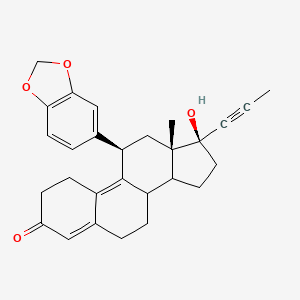Drug Information
| Drug General Information | Top | |||
|---|---|---|---|---|
| Drug ID |
D9HQE2
|
|||
| Drug Name |
PT-150
|
|||
| Synonyms |
PT150; PT-150; SCH-900636; CHEMBL3545391; SCHEMBL11914193; SCH 900636; (11R,13S,17S)-11-(1,3-benzodioxol-5-yl)-17-hydroxy-13-methyl-17-prop-1-ynyl-1,2,6,7,8,11,12,14,15,16-decahydrocyclopenta[a]phenanthren-3-one
Click to Show/Hide
|
|||
| Drug Type |
Small molecule
|
|||
| Indication | Alcohol use disorder [ICD-11: 6C40.2] | Phase 1 | [1] | |
| Company |
Pop Test Cortisol Cliffside Park, NJ
|
|||
| Structure |
 |
Download2D MOL |
||
| Formula |
C28H30O4
|
|||
| Canonical SMILES |
CC#CC1(CCC2C1(CC(C3=C4CCC(=O)C=C4CCC23)C5=CC6=C(C=C5)OCO6)C)O
|
|||
| InChI |
InChI=1S/C28H30O4/c1-3-11-28(30)12-10-23-21-7-4-17-13-19(29)6-8-20(17)26(21)22(15-27(23,28)2)18-5-9-24-25(14-18)32-16-31-24/h5,9,13-14,21-23,30H,4,6-8,10,12,15-16H2,1-2H3/t21?,22-,23?,27+,28+/m1/s1
|
|||
| InChIKey |
DFELGYQKEOCHOA-RBXNTRDFSA-N
|
|||
| PubChem Compound ID | ||||
| Target and Pathway | Top | |||
|---|---|---|---|---|
| Target(s) | Glucocorticoid receptor (NR3C1) | Target Info | Antagonist | [2] |
| KEGG Pathway | Neuroactive ligand-receptor interaction | |||
| NetPath Pathway | IL2 Signaling Pathway | |||
| TCR Signaling Pathway | ||||
| Pathway Interaction Database | Regulation of nuclear SMAD2/3 signaling | |||
| Signaling events mediated by HDAC Class II | ||||
| FOXA2 and FOXA3 transcription factor networks | ||||
| Glucocorticoid receptor regulatory network | ||||
| Regulation of Androgen receptor activity | ||||
| AP-1 transcription factor network | ||||
| Reactome | BMAL1:CLOCK,NPAS2 activates circadian gene expression | |||
| WikiPathways | Serotonin Receptor 4/6/7 and NR3C Signaling | |||
| SIDS Susceptibility Pathways | ||||
| Nuclear Receptors Meta-Pathway | ||||
| Endoderm Differentiation | ||||
| Hair Follicle Development: Cytodifferentiation (Part 3 of 3) | ||||
| Adipogenesis | ||||
| Circadian Clock | ||||
| Nuclear Receptors | ||||
| References | Top | |||
|---|---|---|---|---|
| REF 1 | ClinicalTrials.gov (NCT04331288) Effects of Ethanol on the Pharmacokinetics of PT-150 (Formerly ORG34517) (PT150 PK Study). U.S. National Institutes of Health. | |||
| REF 2 | CRF(1) but not glucocorticoid receptor antagonists reduce separation-induced distress vocalizations in guinea pig pups and CRF overexpressing mouse pups. A combination study with paroxetine. Pharmacol Biochem Behav. 2017 Mar;154:11-19. | |||
If You Find Any Error in Data or Bug in Web Service, Please Kindly Report It to Dr. Zhou and Dr. Zhang.

